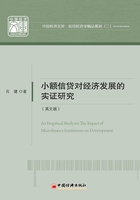
3. MFIs' Challenges
MFIs face many challenges such as high - interest rates and low outreach. In the following sections, I will briefly introduce those challenges.
3.1 Interest Rates
Why do Microfinance loans charge higher interest rates than traditional banking?
Because when you compare small loans with large loans, small loans are much more expensive to process because small loans take a longer time to process. Due to lack of employment history or collateral, microfinance loans need to have a more thoughtful assessment to decide whether borrowers have a worthy credit. "MFIs have to assign a representative to visit the borrowers as a necessary part of the loan process."(16) In remote or sparsely populated areas, the cost of the process becomes much more costly than in larger cities.
When a loan officer approves a loan, MFIs have to assign an officer to defray loans and collect repayments in person, which also significantly increases loan cost when compared with the traditional banks loan process. MFIs have to charge a higher rate compared with traditional banks to cover the high run cost and keep the finance service available to poor people. But there is still some good news, which is that new business models and technology are creating opportunities to cut MFIs run costs which allow them to reach out more people.
For instance, as technology develops, MFIs could use mobile devices to send money and agents could speak with customers over a phone call. "Agent could use a computer to defray loans and collect repayments instead of sending a real person to sparsely populated areas to deal with these transactions."(17) It helps MFIs to cut their run cost and at the same time to reduce loan cost to poor people.
MFIs have to cover three kinds of operating costs when they make small loans to poor people. The first two, the money cost, which the cost of loan defaults and the cost of loan lend, is the part of the amount money lent to poor people. For example, MFIs have to pay 10% of the cost when the money to poor people lends and 1% of the amount lent defaults. Then, adding these two costs together equals $110 for a loan of $1000, and $550 for a loan of $5000. So that 11% of the loan interest rate covers both costs for small loans. The third type of cost, transaction costs is not the part of the amount of money lent to poor people. The $5000 loan transaction cost is the same as the $1000 loan transaction cost. "Because both loans need the same length of time that for an officer to meet with a borrower to check the borrower, the officer needs to process the loan, collect repayments and watch the borrower."(18)
For example, $25 is the transaction cost per loan and of one year loan. For a $500 loan, MFIs have to charge of $50 + 5 + $25 = $80 that equals 16% an annual interest rate. At first glance, a high-interest rate exploits many poor people. However, MFIs have to cover their cost that the operate costs cannot be charged below certain minimums when dealing with small loan borrowers.
3.2 Reach versus Depth of Impact
The trade-off between outreach and sustainability has been debated for a long time. "If MFIs pursue their maximum profit, this will lead MFIs away from poor people, which goes against Microfinance Institutions' social goal to serve poor people who need access to financial services. Although serving very poor people will earn less profit than reaching better-off clients, it is a social goal for Microfinance Institutions to help poor people who MFIs' objectives and not a firm to choose to maximize profit. It is not a conflict problem for Microfinance Institutions to choose between serving the very poor people and earning profit. MFIs show that serving the very poor people promotes their financial conditions. In rural areas of Bangladesh, Microfinance programs (Bangladesh Rural Advancement Committee and ASA) have already shown that a profit can be reached by serving very poor people. Both Microfinance programs have shown that more than 4% of assets increased in 2000. However, there are still some cases that Microfinance programs lose money. For instance, if potential clients are risk-averse and extremely poor and they live in remote areas with very low population density, this could result in a loss of profit. Microfinance programs may need some extra subsidies. MFIs need to show that Microfinance programs have a position to impact poor household and their clients will be better off when Microfinance programs receive subsidies."(19)
(1)http://socialwork.oxfordre.com.
(2)www.worldbank.com.
(3)Dr. Mohammad Yunus was awarded the Nobel Peace Prize for founding the Grameen Bank and pioneering the concepts of microcredit and microfinance. https://en.wikipedia.org/wiki/Muhammad_Yunus.
(4)Dr. Mohammad Yunus associate with Saskia Bruysten, Sophie Eisenmann and Hans Reitz, pioneering the concepts of microcredit and microfinance.
(5)CGAP (the Consultative Group to Assist the Poor) is a global partnership of 34 leading organizations that seek to advance financial inclusion. CGAP develops innovative solutions through practical research and active engagement with financial service providers, policy makers, and funders to enable approaches at scale. http://www.cgap.org/about.
(6)Microfinance: A tool for poverty reduction. http://digitalcommons.uri.edu.
(7)Global recession and sustainable development by Dr. Dragan Loncar.
(8)https://en.wikipedia.org/wiki/Microfinance.
(9)http://www.microworld.org/en/about-microworld/about-microcredit.
(10)http://microfinance.cfsites.org/custom.
(11)Source: CGAP (the Consultative Group to Assist the Poor). www.cgap.org.
(12)https://en.wikipedia.org/wiki/Aid.
(13)https://en.wikipedia.org/wiki/Microfinance.
(14)http://www.ruralfinanceandinvestment.org.
(15)https://en.wikipedia.org/wiki/Microfinance.
(16)http://indiamicrofinance.com.
(17)https://www.sec.gov.
(18)http://www.bankrate.com.
(19)Source: CGAP (the Consultative Group to Assist the Poor).www.cgap.org/about/faq